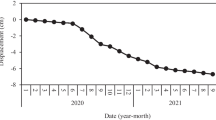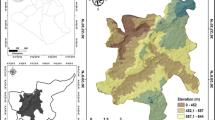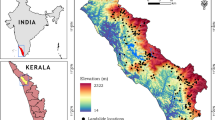Abstract
Land subsidence susceptibility mapping is a necessary prerequisite for land subsidence management. Proper assessment of land subsidence requires determining parameters affecting subsidence to discover the spatial relationships with subsidence. For this purpose, two frameworks were prepared, according to the land site subsidence, eight parameters affecting the subsidence in the Damaneh-Daran plain. In the first framework, eight parameters including annual groundwater level drawdown, aquifer medium, land use, discharge, aquifer saturation thickness, net recharge, fault proximity and topography called PWRSTFAL based on weighting parameters and the second model based on optimization and compatibility of eight active layers on subsidence, were prepared by AHP-fuzzy method and the final map of subsidence vulnerability obtained. Radar images and the InSAR method validated the methods. The results show that both maps show a good correlation with radar data. Still, the map prepared by the AHP-fuzzy method offers the highest correlation with radar data and subsidence in the plain. It separates subsidence vulnerability in more detail on the whole surface of the plain. According to this model, most plain areas, especially the eastern part, are subject to subsidence, and management programs should control subsidence. The results ROC diagram obtained from the performance of the PWRSTFAL framework based on the AHP-fuzzy method was more promising than the ordinary PWRSTFAL framework.






Similar content being viewed by others
References
Abdollahi, S., Purghasemi, H., Ghanbarian, Gh., Safaian, R. (2019). Spatial simulation and land-subsidence susceptibility mapping using maximum entropy model, Journal of Watershed Management Research, autumn and winter: 133–144
Adiyaman, I. B. (2012). Land subsidence and earth fissure due to groundwater pumping: [Dissertation] (p. 199). University of Arizona.
Buckley, F., O’Sullivan, K., Mee, J. F., Evans, R. D., & Dillon, P. (2003). Relationships among milk yield, body condition, cow weight, and reproduction in spring-calved Holstein-Friesians. Journal of Dairy Science, 86, 2308–2331.
Budhu, M., & Adiyaman, I. B. (2010). Mechanics of land subsidence due to groundwater pumping. International Journal for Numerical and Analytical Methods in Geomechanics, 34(14), 1459–1478. https://doi.org/10.1002/nag.863
Chaussard, E., Wdowinski, Sh., Cano, E., & C., Amelunga, F. (2014). Land subsidence in central Mexico detected by ALOS InSAR time-series. Remote Sensing of Environment, 140, 94–106. https://doi.org/10.1016/j.rse.2013.08.038
Chen, B., Gong, H., Li, X., Lei, K., Ke, Y., Duan, G., & Zhou, Ch. (2015). Spatial correlation between land subsidence and urbanization in Beijing, China. Natural Hazards, 75, 2637–2652. https://doi.org/10.1007/s11069-014-1451-6.
Firdaus. H. S., Prasetyo, Y., Diyanah, D. (2018). Spatial correlation analysis of land subsidence and the water table changes in unconfined aquifers using sentinel1-sar image and geographic information systems (case study: Semarang City – Indonesia). E3S Web of Conferences, 73:03022, 1–5. https://doi.org/10.1051/e3sconf/2018730302203022
Galloway, D. L., & Burbey, T. J. (2011). Regional land subsidence accompanying groundwater extraction. Hydrogeology Journal, 19, 1459–1486. https://doi.org/10.1007/s10040-011-0775-5
Galloway, D. L., & Hoffmann, J. R. (2007). The application of satellite differential SAR interferometry-derived ground displacements in hydrogeology. Hydrogeology Journal, 15, p133-154.
Gharekhani, M., Nadiri, A., Khatibi, R.,Sadeghfam, S. An investigation into time-variant subsidence potentials using inclusive multiple modelling strategies, Journal of Environmental Management, 12 Jun 2021, 294:112949. https://doi.org/10.1016/j.jenvman.2021.112949
Ghodusipor, H. (2019). Analytic hierarchy process (AHP) (p. 222). Amirkabir University of Technology.
Lin, H., Kao, J., Li, K., and Hwang, H. (1996). Fuzzy GIS assisted landfill silting analysis, Proceedings of international conference on Solid waste technology and management.
Malczewski, J. (1999). GIS and multi criteria decision analysis. John Wiley and so as Inc, 408.
MarÍa, J., Jimenez, M., Joven, J. A., Pirla, A. R., & Lanuza, A. T. (2005). A spreadsheet module for consistent consensus building in AHP-group decision making. Group Decision and Negotiation, 14, 89–108. https://doi.org/10.1007/s10726-005-2407-8
Martínez, J. P., Marín, M. H., Burbey, J. T., Cervantes, N. L., José, Á. O., De-Leon, M. E., & Pintoc, A. S. (2013). Land subsidence and ground failure associated to groundwater exploitation in the Aguascalientes Valley, Mexico. Engineering Geology, 164, 172–186. Https://doi.org/10.1016/j.enggeo.2013.06.015.
Meldebekova, G., Yu, Ch., Li, Zh., & Song, Ch. (2020). Quantifying ground subsidence associated with aquifer overexploitation using space-borne radar interferometry in Kabul, Afghanistan. Remote Sensing, 12(2461), 1–21. https://doi.org/10.3390/rs12152461
Motagh, M., Thomas, R. W., Sharifi, M. A., Fielding, E., Schenk, A., Andersson, J., & Zschau, J. (2008). Land subsidence in Iran caused by widespread water reservoir overexploitation. Geophysical Research Letters, 35, L16403. https://doi.org/10.1029/2008GL033814,2008
Naderi, K., Nadiri, A., Asgharimoghadam, A., & Kord, M. (2015). A new method for identifying and determining areas at risk of subsidence (case study: Aquifer of Salmas plain). Eco Hydrology JouRnal, Issue, 5(1), 85–97.
Nadiri, A., Taheri, Z., Khatibi, R., Barzegari, Gh., & Dideban, Kh. (2018). Introducing a new framework for mapping subsidence vulnerability indices (SVIs): ALPRIFT. Science of the Total Environment, 628–629, 1043–1057. https://doi.org/10.1016/j.scitotenv.2018.02.031
Niekerk, V., & Walt, V. D. (2006). Dewatering of the Far West Rand dolomitic area by gold mining activities and subsequent ground instability. Land Degradation and Development, 17(4), 441–452. https://doi.org/10.1002/ldr.749
Raucoules, D., Colesanti, C., & Carnec, C. (2007). Use of SAR interferometry for detecting and assessing ground subsidence. C. r. Geoscience, 339, 289–302. https://doi.org/10.1016/j.crte.2007.02.002
Sadeghfam, S., Khatibi, R., Dadashi, S., & Nadiri, A. (2020). Transforming subsidence vulnerability indexing based on ALPRIFT into risk indexing using a new fuzzy-catastrophe scheme. Environmental Impact Assessment Review, 82(2020), 106352. https://doi.org/10.1016/j.eiar.2019.106352
Scanlon, B., Healy, R., & Cook, P. (2002). Choosing appropriate techniques for quantifying groundwater recharge. Journal of Hydrology, 10(1), 18–39. https://doi.org/10.1007/s10040-001-0176-2
Trinh, M. T., & Fredlund, D. G. (2000). Modeling subsidence due to ground water extraction in the Hannoi city area. Journal of Geology Technology, 37, 621–637.
Tzeng, G. H., & Teng, M. H. (2002). Multicriteria selection for a restaurant location in Taipei. International Journal of Hospitality Management, 21, 171–187. https://doi.org/10.1016/S0278-4319(02)00005-1
Yin, J., Yu, D., Wilby, R. (2015). Modelling the impact of land subsidence on urban pluvial flooding: A case study of downtown Shanghai, China. Science of the total environment, 544:744–753. Https: // doi. Org /10.1016 /j. scitotenv .2015.11.159
Acknowledegments
The work was funded by the Research Assistant of the Shahid Chamran University of Ahvaz. Sentinel1. Data were obtained from the European Space Agency (ESA), and geological and hydrogeological data were provided by Isfahan Regional Water Company.
Author information
Authors and Affiliations
Corresponding author
Additional information
Publisher's Note
Springer Nature remains neutral with regard to jurisdictional claims in published maps and institutional affiliations.
Rights and permissions
About this article
Cite this article
Chitsazan, M., Rahmani, G. & Ghafoury, H. Land subsidence susceptibility mapping using PWRSTFAL framework and analytic hierarchy process: fuzzy method (case study: Damaneh-Daran Plain in the west of Isfahan Province, Iran). Environ Monit Assess 194, 192 (2022). https://doi.org/10.1007/s10661-021-09645-3
Received:
Accepted:
Published:
DOI: https://doi.org/10.1007/s10661-021-09645-3




